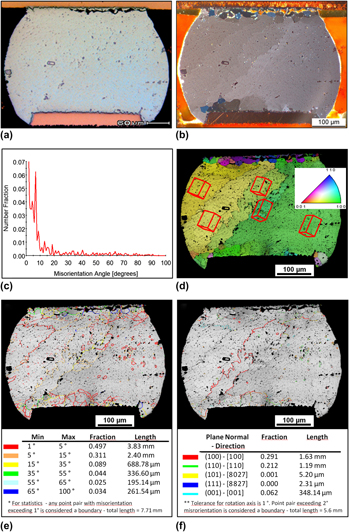Crossref Citations
This article has been cited by the following publications. This list is generated based on data provided by
Crossref.
Chen, Hongtao
Han, Jing
and
Li, Mingyu
2011.
Localized Recrystallization Induced by Subgrain Rotation in Sn-3.0Ag-0.5Cu Ball Grid Array Solder Interconnects During Thermal Cycling.
Journal of Electronic Materials,
Vol. 40,
Issue. 12,
p.
2470.
Chen, H.T.
Wang, L.
Han, J.
Li, M.Y.
Wu, Q.B.
and
Kim, J.M.
2011.
Grain Orientation Evolution and Deformation Behaviors in Pb-Free Solder Interconnects Under Mechanical Stresses.
Journal of Electronic Materials,
Vol. 40,
Issue. 12,
p.
2445.
Zhang, Q.K.
and
Zhang, Z.F.
2012.
In situ tensile creep behaviors of Sn–4Ag/Cu solder joints revealed by electron backscatter diffraction.
Scripta Materialia,
Vol. 67,
Issue. 3,
p.
289.
Wang, C.Q.
Zhong, Y.
Caers, J.F.J.M.
Zhao, X.J.
Li, B.
and
Liu, B.L.
2012.
Relationship between crack propagation trends and grains in SnAgCu interconnects.
p.
1200.
Chen, Hongtao
Mueller, Maik
Mattila, Toni Tuomas
Li, Jue
Liu, Xuwen
Wolter, Klaus-Juergen
and
Paulasto-Kröckel, Mervi
2012.
Localized recrystallization and cracking of lead-free solder interconnections under thermal cycling – ERRATUM.
Journal of Materials Research,
Vol. 27,
Issue. 6,
p.
978.
Chen, Hongtao
Han, Jing
Li, Jue
and
Li, Mingyu
2012.
Inhomogeneous deformation and microstructure evolution of Sn–Ag-based solder interconnects during thermal cycling and shear testing.
Microelectronics Reliability,
Vol. 52,
Issue. 6,
p.
1112.
Che, F.X.
and
Pang, John H.L.
2012.
Characterization of IMC layer and its effect on thermomechanical fatigue life of Sn–3.8Ag–0.7Cu solder joints.
Journal of Alloys and Compounds,
Vol. 541,
Issue. ,
p.
6.
Chen, Hongtao
Wang, Ling
Han, Jing
Li, Mingyu
and
Liu, Hao
2012.
Microstructure, orientation and damage evolution in SnPb, SnAgCu, and mixed solder interconnects under thermomechanical stress.
Microelectronic Engineering,
Vol. 96,
Issue. ,
p.
82.
Chen, Hongtao
Li, Jue
and
Li, Mingyu
2012.
Dependence of recrystallization on grain morphology of Sn-based solder interconnects under thermomechanical stress.
Journal of Alloys and Compounds,
Vol. 540,
Issue. ,
p.
32.
Chen, Hongtao
Yan, Bingbing
Yang, Ming
Ma, Xin
and
Li, Mingyu
2013.
Effect of grain orientation on mechanical properties and thermomechanical response of Sn-based solder interconnects.
Materials Characterization,
Vol. 85,
Issue. ,
p.
64.
Mattila, Toni T.
2013.
TMS2013 Supplemental Proceedings.
p.
401.
Hokka, Jussi
Mattila, Toni T.
Xu, Hongbo
and
Paulasto-Kröckel, Mervi
2013.
Thermal Cycling Reliability of Sn-Ag-Cu Solder Interconnections—Part 2: Failure Mechanisms.
Journal of Electronic Materials,
Vol. 42,
Issue. 6,
p.
963.
Che, F. X.
and
Pang, John H. L.
2013.
Fatigue Reliability Analysis of Sn–Ag–Cu Solder Joints Subject to Thermal Cycling.
IEEE Transactions on Device and Materials Reliability,
Vol. 13,
Issue. 1,
p.
36.
Mattila, Toni T.
Hokka, Jussi
and
Paulasto-Kröckel, Mervi
2014.
The Reliability of Microalloyed Sn-Ag-Cu Solder Interconnections Under Cyclic Thermal and Mechanical Shock Loading.
Journal of Electronic Materials,
Vol. 43,
Issue. 11,
p.
4090.
Zhou, Bite
Muralidharan, Govindarajan
Kurumadalli, Kanth
Parish, Chad M.
Leslie, Scott
and
Bieler, Thomas R.
2014.
Microstructure and Sn Crystal Orientation Evolution in Sn-3.5Ag Lead-Free Solders in High-Temperature Packaging Applications.
Journal of Electronic Materials,
Vol. 43,
Issue. 1,
p.
57.
Gao, Hong
Ma, Jianhua
Gao, Lilan
Yu, Dunji
and
Sun, Jinsheng
2015.
Thermal cycling aging effects on the ratcheting behavior of anisotropic conductive film.
Soldering & Surface Mount Technology,
Vol. 27,
Issue. 4,
p.
185.
Lee, Tae-Kyu
Bieler, Thomas R.
Kim, Choong-Un
and
Ma, Hongtao
2015.
Fundamentals of Lead-Free Solder Interconnect Technology.
p.
113.
Zhong, Ying
Wang, Chunqing
Zhao, Xiujuan
and
Caers, J.F.J.M.
2015.
The influence of high melting point elements on the reliability of solder during thermal shocks.
p.
2162.
Zhou, Bite
Zhou, Quan
Bieler, Thomas R.
and
Lee, Tae-kyu
2015.
Slip, Crystal Orientation, and Damage Evolution During Thermal Cycling in High-Strain Wafer-Level Chip-Scale Packages.
Journal of Electronic Materials,
Vol. 44,
Issue. 3,
p.
895.
Zhong, Ying
Liu, Wei
Wang, Chunqing
Zhao, Xiujuan
and
Caers, J.F.J.M.
2016.
The influence of strengthening and recrystallization to the cracking behavior of Ni, Sb, Bi alloyed SnAgCu solder during thermal cycling.
Materials Science and Engineering: A,
Vol. 652,
Issue. ,
p.
264.
